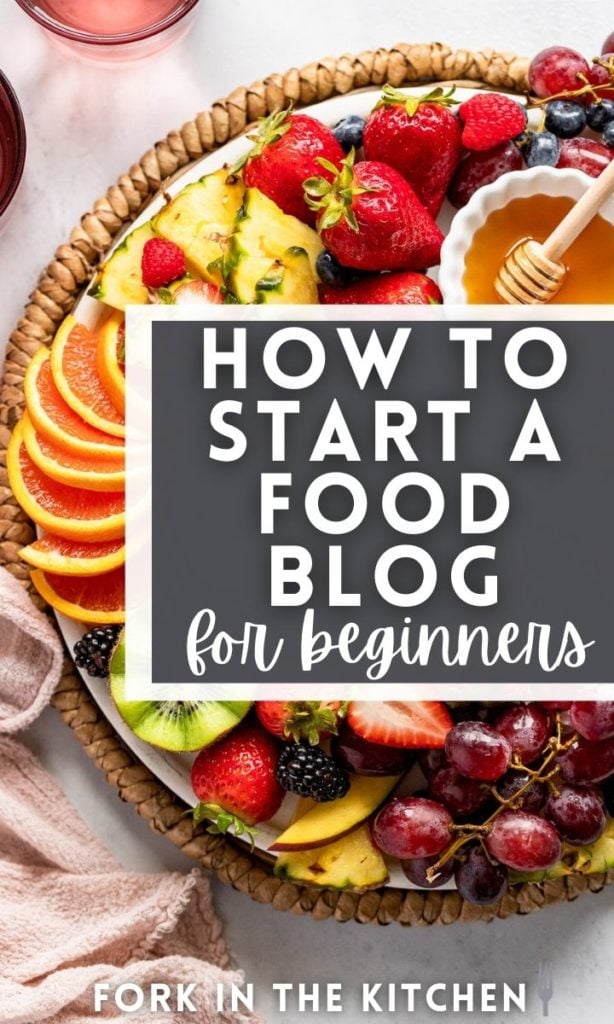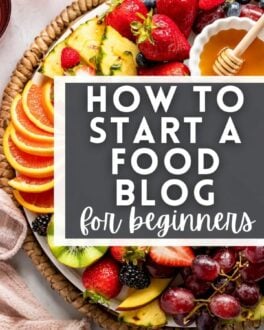5 Key Steps: How to Start a Food Blog for Beginners
If you love food, cooking, or baking…or all three, then maybe you’ve thought of starting your own food blog before. And the first question that rushes in after the idea hits is probably somewhere along the lines of “ok, but how do I actually start a food blog?!”.

I get it. I was there once, wondering where I was going to start when the technical side of starting a blog was staring me straight in the eyes. What was a host? And a theme? And how in the world do I actually make this look like this?!
I’m happy to say that I’ve learned a lot in the many years of running my own food blog, and after fielding many questions from beginning bloggers about where to start, I’m happy to share my favorite resources, tips, and tricks to creating your own successful food blog.
This page contains some affiliate links, which means I may earn a commission if you choose to purchase a product through one of the links. I only link to products I have personally used and can genuinely recommend.
Table of Contents
Set the Foundation: Decide on a Niche
These days, creating a successful, profitable food blog requires more work than simply picking a name and posting whichever recipes tickle your fancy. Now, of course, I will not discourage you from doing this if your goal is to have a creative outlet.
On the other hand, if you are hoping to generate a profit to at least offset costs or turn it into a full-time business, which I assume you are if you are reading this, I highly recommend choosing a niche.
A niche will give both attract the kind of readers you want and turn them into loyal, returning fans, and help you create content.
It doesn’t have to be gluten-free, dairy-free, or diet-specific at all. What are you passionate about? What do others ask you about? What kind of food do you naturally gravitate towards while you’re cooking? Do you have unique skills that can be your focus?
I knew that because I cook mostly meatless meals and have a focus on reducing meat consumption for a variety of reasons, Fork in the Kitchen would gravitate towards being a vegetarian blog.
As you continue the process, you will nail down brand colors, a logo, and other specifics. For now, decide what you want the focus of your blog to be, and then it’s time to decide on a name and purchase a domain!
What is a Blogging Platform?
Before we continue, we’ve got to talk about your blogging platform. A blogging platform is where you will create and publish your content and design your vision for what you want your site to look like. There are two routes: a free platform and a self-hosted, customized platform.
This post is written for those who want to self-host their site and have the most control over features, create their own design (which can be easy to do with templates, too, no coding is required), etc.
This is the route to take when you want to have your own direct domain name. The most popular platform for a self-hosted website is wordpress.org.
On the other hand, you can use a free web hosting platform like wordpress.com or blogger.com. They will have much more basic features and you will be limited with design, plug-ins to customize your site, etc.
Again, I highly recommend starting with wordpress.org as your platform; it’s the most commonly used platform around the world, is user-friendly, and you will have the most resources and information available to assist you in your journey.
Choose a Name & Purchase A Domain
Before you dive into purchasing a domain for your website, you’ll need to make sure you have a name that you love. A few things to keep in mind while deciding on a blog name:
- Do a quick Google search. Make sure the name is not already taken, and that there isn’t a similarly named site, brand, or like. A Trademark search is a good idea in this case, too.
- Keep it short and sweet — and easy to remember! You definitely want people to remember your name. You want to be sure that when it’s spelled out in a domain or on social media (i.e. without spaces) that it looks like what you want it to and doesn’t read like another name.
- Consider a name that gives your audience an idea of what it’s going to be about (in this case…food, cooking, etc.)
Once you’ve chosen a name and have done your homework to ensure it’s not already in use in some form or another…it’s time to purchase a domain!
I have always used Google Domains; it’s very user-friendly and reliable, and you can choose your web host. The cost of a domain is around $10-15 a year unless you’re looking for a very sought-after name, in which case it can be much pricier.
Choose a (reliable!) Web Host Provider
When self-hosting a website on wordpress.org, you’ll need to find a web host to essentially “house” your website. The host is where your website lives. It’s important to choose a reliable host that will keep your site up and running, and keep your site speed fast.
You are bound to see a lot of information specifically about Bluehost. I first started hosting Fork in the Kitchen on Bluehost because of their amazing starting price. It is worth the price if you are just starting out while you get the hang of things…but not for much longer.
So that being said, in good faith, I don’t recommend starting with Bluehost. It will be easier, in the long run, to start with a host you can grow with; one that has a good track record and won’t leave you with a headache.
I’ve hosted my site with Cloudways for over 5 years and have had a great experience so far. They were able to migrate my site over and any time my site has unexpectedly gone down (it happens to everyone) their support has been helpful and responsive. Their interface is user-friendly and intuitive. Even better? They are very reasonably priced as you only pay for what you use.
Cloudways isn’t the only option though, just the one I personally have experience with. I have heard that others also love BigScoots, SiteGround, and WPEngine. There are many more out there, too, that you can absolutely research.
Install WordPress and a Theme
Now that you have a blog name and a host, it’s time to get started creating your actual website!
The steps for installing WordPress on your site (i.e. your domain) will depend on your host. For example, if using Bluehost, WordPress is already installed on your site automatically. Cloudways has directions for installing WordPress, and your specific host will be able to provide you with the best instructions for doing so.
Food Blog Theme
Your WordPress theme is going to determine the look and feel of your site – from layout to fonts, to colors, and more. Think of it like your site’s outfit. There are many themes available for free or to purchase. To make visiting your website a great experience for readers, it’s important to choose a theme that is well-designed, responsive, mobile-friendly, optimized, and user-friendly. Oh, and support for it is great too.
With that in mind…I’m recommending that you purchase a theme for those reasons and more. Again, we’re avoiding the headaches and setting our site up for success!
My site runs on the Genesis Framework through StudioPress. It’s through that framework that you choose a theme (design and layout). They have a wonderful selection of beautiful themes that are most importantly, functional and responsive.
A very popular theme for food blogs was the Foodie Pro theme; it’s specifically designed for food blogs and is easy to use right away after installation. Now, in 2022, the themes are currently only available through the Feast Plug-in, which gives you access to 5 different themes plus enhanced SEO, page speed, core web vitals, and accessibility.
What’s Next?
Now you have your domain, a web host, and a theme! You can design your site through your theme to match your vision, but don’t put too much pressure on finalizing it all right away. It will take some time and trial-and-error to know exactly the layout you want.
You’ll want to look into adding WordPress plug-ins for your site (a recipe card plug-in is super important!) and set up Google tools to help you track your site. More on both of those in my blogging resources post.
Frequently Asked Questions
The start-up cost for a food blog is going to vary depending on if you want to host your own website (which I recommend) or host on a free platform. For hosting your own site, a domain is typically $10-15. You’ll need to host it too though, which can cost anywhere from $3 to $50 a month. You will likely also have the cost of your theme.
Again, this will vary depending on traffic and more. Food bloggers can make no money to thousands of dollars a month.
You can blog as a hobby with no intention of making money or implement specific strategies like keyword research and SEO in order to increase traffic. With more traffic, you can join ad networks to bring in steady income. Food bloggers can also make money through affiliate sales, creating their own products, and more.
Is the market too saturated to start a food blog now? I say there’s no better time than the present! Narrow in on your niche to really stand out in the crowd and find your people.
Have other questions?! Need more help? Be sure to leave a comment below!





Great post. Keep posting.
Glad you enjoyed!
The way you wrote the post, I’m in love with your posting. Thank you so much for this an informative post.